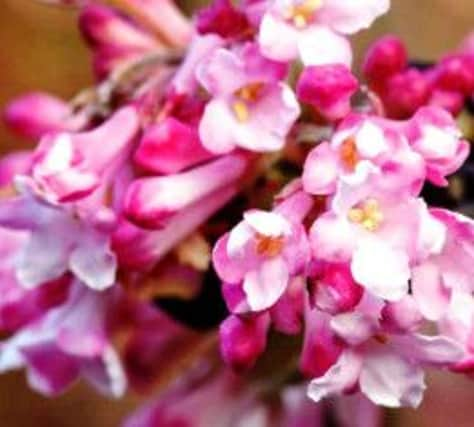Bloomers for winter


Viburnum x bodnantense “Dawn” is one of them, and it’s a star worth cultivating, although once upon a time it was considered anything but. That was way back in 1933 when Charles Lamont, assistant curator at the Royal Botanic Garden, Edinburgh, crossed Viburnum farreri (formerly V fragrans) and V grandiflorum. He had hoped to produce something better than the parents but what he saw left him disappointed, so he threw them on the compost heap.
But within two years, the same cross was done at Bodnant, the National Trust garden in North Wales, and instead of disappointment, there came a new dawn.
Advertisement
Hide AdAdvertisement
Hide AdIt was the first cultivar to be named; “Deben” was another and, after he died, “Charles Lamont” was also named in honour of the man who started the whole thing off.
Today, thousands of people grow Viburnum x bodnantense “Dawn” for its dark pink, fragrant flowers that age to white; “Charles Lamont” is similar, but the flowers are a purer, brighter pink and they help brighten the winter.
V bodnantense is fair-sized shrub which does best in a sunny site where the soil is moist and rich. As it flowers on bare stems, it’s best planted against a green background so it can show off its blooms to the best effect.
The genus Viburnum contains about 200 evergreen and deciduous shrubs and small trees. Some are grown just for their flowers; others because they also have attractive fruit and foliage – the fruits are usually small and spherical, and black, blue or red, but V opulus “Xanthocarpum”, a cultivar of the guelder rose, has bright yellow berries.
Advertisement
Hide AdAdvertisement
Hide AdMany of the deciduous viburnums, such as V dentatum, also provide spectacular autumn colour.
Probably the favourite viburnum grown today is V tinus, and, in particular, “Eve Price”, an accommodating evergreen shrub for winter interest. It has dense dark green foliage and flowers which appear over a long period from late winter to spring. It’s easy to propagate, easy to shape to size and can even be grown as a hedge.
How your garden could be bee’s knees for pollinators
For something so small, the humble bee has a big following and has recently made the news yet again. Apparently, we should treat bees as though they were Premiership footballers – they deserve the best food and the best accommodation the gardener can offer.
I agree; bees are beneficial, bees are busy and industrious, bees play an integral part in the life of plants, and, therefore, in the lives of human beings.
Advertisement
Hide AdAdvertisement
Hide AdSo before you squash that bee, think carefully – it’s been estimated that, without it and its billions of little cousins, it would cost the UK £1.8bn every year to hand-pollinate crops.
In recent years, Britain has lost more than half the honeybees kept in managed hives – and wild honeybees are nearly extinct. Some species of bumblebee have been lost altogether.
One reason for their decline is a shortage of natural habitats, but there are steps people can take in their gardens to help provide it:
Sow bee-friendly seeds and plant bee-friendly flowers such as mixed wildflowers packets, single-flowering roses, open and flat-headed flowers like verbena and yarrow, and tubular-shaped flowers such as foxgloves.
Advertisement
Hide AdAdvertisement
Hide AdCreate a place to nest for solitary bees by piling together hollow stems and creating a “bee hotel”.
Try to provide a small amount of rainwater in a shallow birdbath or tray which honeybees need to keep their hive at the right temperature.
The latest plea to help the bee came from Environment Secretary Elizabeth Truss, who said gardeners should give up their lawnmowers and let their grass go rogue to protect daisies and lavender, which provide vital pollen for bees and other pollinators.
She was announcing a new 10-year bee and pollinator strategy – including a £900m Countryside Stewardship scheme to provide payments to farmers to maintain hedgerows and other “wildlife-friendly ground round the edges of arable fields”.